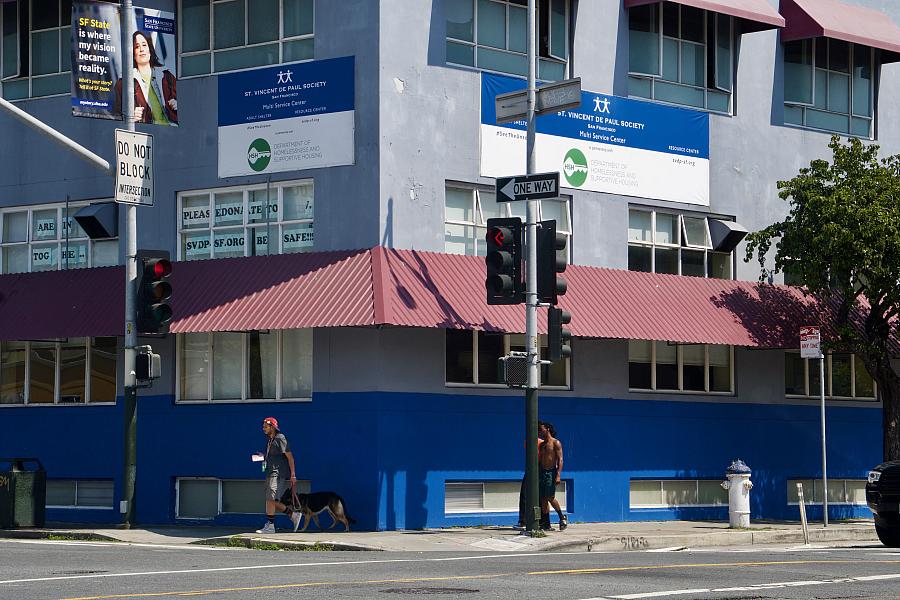How effective is San Francisco in sheltering people experiencing homelessness?

Access to shelters and how the city addresses homelessness on its streets is at the center of a heated debate in San Francisco.
Photo by Madison Alvarado/San Francisco Public Press
In late August, surrounded by throngs of dozens of protesters and counter-protestors, San Francisco Mayor London Breed yelled over the din of chants and sirens: “We want a reversal of this injunction that makes it impossible to do our jobs.”
Breed was referring to an injunction in place since December 2022 that prevents city officials from enforcing laws on sitting, lying or sleeping on public property.
The scene outside the Ninth Circuit of Appeals was one of the latest battlegrounds in the fight between people experiencing homelessness — backed by the Coalition on Homelessness and the American Civil Liberties Union — and the city of San Francisco over how the government responds to homeless encampments. The court recently clarified that the injunction only applies to individuals who are involuntarily homeless, and not those who refuse shelter or have shelter elsewhere.
At the heart of this ongoing debate are two conflicting narratives: one pushed by the city that it cannot address homelessness while people are refusing shelter, and the other by advocates who say sweeps constitute cruel and unusual punishment when San Francisco does not have enough beds for everyone experiencing homelessness.
Though the city’s 2022 census of its homeless population showed a slight decrease in the number of unhoused residents, it is widely acknowledged that the city does not have enough shelter beds to meet demand. Officials recorded 7,754 people experiencing homelessness in August 2022, while there are only 3,154 shelter beds. Moreover, the Department of Homelessness and Supportive Housing’s website notes that the annual census is likely an undercount, estimating that San Francisco could have as many as 20,000 people who experience homelessness in a given year.
San Francisco publicly shares data online regarding its outreach to unhoused people, but the dashboards don’t tell the whole story. While a layperson may grow frustrated at an inventory showing vacant beds or reports that people are refusing shelter, my preliminary reporting has shown that there is a dearth of people requesting shelter through a city voicemail line, and those who do use the service often don’t receive the help they seek because the Homeless Outreach Team is unable to locate or get in contact with them for various reasons.
The question I seek to address with this project for the 2023 Data Fellowship is: How effective is San Francisco’s homeless response program — specifically its Homeless Outreach Team and coordinated entry system — in connecting our city’s most vulnerable residents with resources, especially shelter beds?
I will analyze underlying data from several public databases, as well as data acquired through records requests focusing on the homeless response system, to provide a richer understanding of the realities of accessing shelter and other support programs funded through the $713.3 million set aside in San Francisco’s Homelessness and Supportive Housing budget for next year.
Beyond gathering the raw numbers, I’ve started conducting interviews with people who are experiencing homelessness, as well as nonprofit housing providers who partner with the city, to understand where the homeless response system is struggling to meet the needs of the people it aims to serve. The consensus among providers is clear: There are not enough shelter beds available for the population that needs them, and many people are falling through the cracks.
I will use the data and interviews to untangle and, as much as possible, quantify the biggest barriers to accessing city resources — barriers often tied to technology, language and accessibility. Many members of the homeless population do not have regular access to a cell phone or the internet, or a way to charge their devices, making it difficult to rely on what might seem like convenient tech solutions, such as an online shelter waitlist or a voicemail hotline. The increasing number of non-English speakers seeking help poses additional hurdles, as the department works to provide interpreters and offer translations on its websites in languages other than English.
My previous reporting has shown that the pathways to shelter in San Francisco are varying and complex. Through this project, I will provide a more nuanced analysis of the data the city has on how wide-reaching and effective its services are — as well as what barriers remain — to set the record straight and hold San Francisco accountable for supporting its most vulnerable populations.

